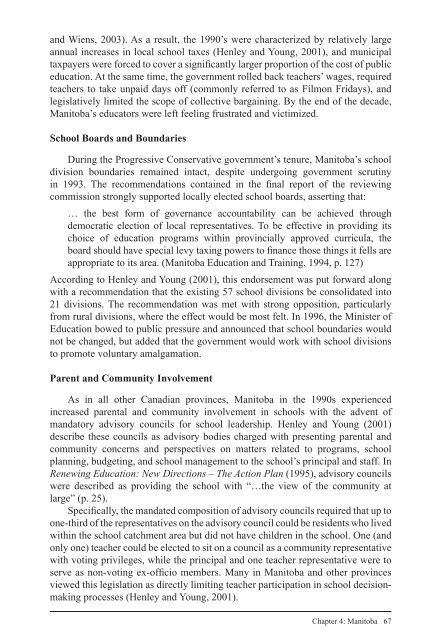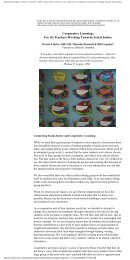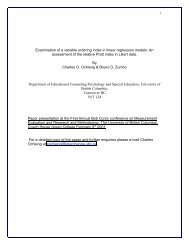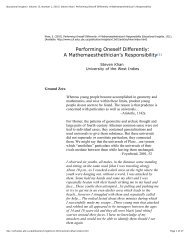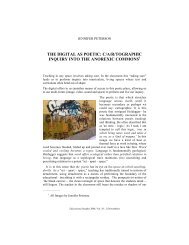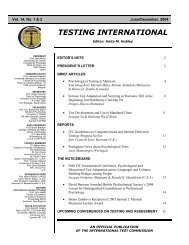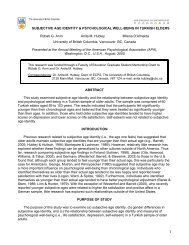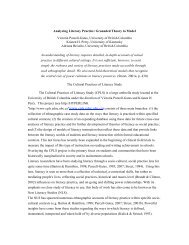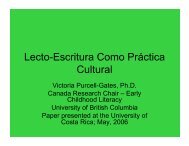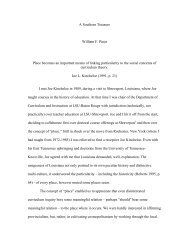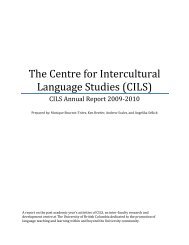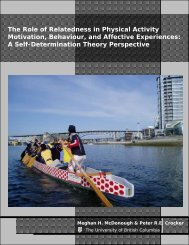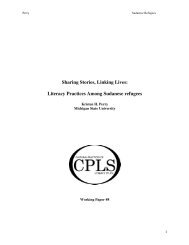The evolution of professionalism - Centre for Policy Studies in ...
The evolution of professionalism - Centre for Policy Studies in ...
The evolution of professionalism - Centre for Policy Studies in ...
Create successful ePaper yourself
Turn your PDF publications into a flip-book with our unique Google optimized e-Paper software.
and Wiens, 2003). As a result, the 1990’s were characterized by relatively large<br />
annual <strong>in</strong>creases <strong>in</strong> local school taxes (Henley and Young, 2001), and municipal<br />
taxpayers were <strong>for</strong>ced to cover a signifi cantly larger proportion <strong>of</strong> the cost <strong>of</strong> public<br />
education. At the same time, the government rolled back teachers’ wages, required<br />
teachers to take unpaid days <strong>of</strong>f (commonly referred to as Filmon Fridays), and<br />
legislatively limited the scope <strong>of</strong> collective barga<strong>in</strong><strong>in</strong>g. By the end <strong>of</strong> the decade,<br />
Manitoba’s educators were left feel<strong>in</strong>g frustrated and victimized.<br />
School Boards and Boundaries<br />
Dur<strong>in</strong>g the Progressive Conservative government’s tenure, Manitoba’s school<br />
division boundaries rema<strong>in</strong>ed <strong>in</strong>tact, despite undergo<strong>in</strong>g government scrut<strong>in</strong>y<br />
<strong>in</strong> 1993. <strong>The</strong> recommendations conta<strong>in</strong>ed <strong>in</strong> the fi nal report <strong>of</strong> the review<strong>in</strong>g<br />
commission strongly supported locally elected school boards, assert<strong>in</strong>g that:<br />
… the best <strong>for</strong>m <strong>of</strong> governance accountability can be achieved through<br />
democratic election <strong>of</strong> local representatives. To be effective <strong>in</strong> provid<strong>in</strong>g its<br />
choice <strong>of</strong> education programs with<strong>in</strong> prov<strong>in</strong>cially approved curricula, the<br />
board should have special levy tax<strong>in</strong>g powers to fi nance those th<strong>in</strong>gs it fells are<br />
appropriate to its area. (Manitoba Education and Tra<strong>in</strong><strong>in</strong>g, 1994, p. 127)<br />
Accord<strong>in</strong>g to Henley and Young (2001), this endorsement was put <strong>for</strong>ward along<br />
with a recommendation that the exist<strong>in</strong>g 57 school divisions be consolidated <strong>in</strong>to<br />
21 divisions. <strong>The</strong> recommendation was met with strong opposition, particularly<br />
from rural divisions, where the effect would be most felt. In 1996, the M<strong>in</strong>ister <strong>of</strong><br />
Education bowed to public pressure and announced that school boundaries would<br />
not be changed, but added that the government would work with school divisions<br />
to promote voluntary amalgamation.<br />
Parent and Community Involvement<br />
As <strong>in</strong> all other Canadian prov<strong>in</strong>ces, Manitoba <strong>in</strong> the 1990s experienced<br />
<strong>in</strong>creased parental and community <strong>in</strong>volvement <strong>in</strong> schools with the advent <strong>of</strong><br />
mandatory advisory councils <strong>for</strong> school leadership. Henley and Young (2001)<br />
describe these councils as advisory bodies charged with present<strong>in</strong>g parental and<br />
community concerns and perspectives on matters related to programs, school<br />
plann<strong>in</strong>g, budget<strong>in</strong>g, and school management to the school’s pr<strong>in</strong>cipal and staff. In<br />
Renew<strong>in</strong>g Education: New Directions – <strong>The</strong> Action Plan (1995), advisory councils<br />
were described as provid<strong>in</strong>g the school with “…the view <strong>of</strong> the community at<br />
large” (p. 25).<br />
Specifi cally, the mandated composition <strong>of</strong> advisory councils required that up to<br />
one-third <strong>of</strong> the representatives on the advisory council could be residents who lived<br />
with<strong>in</strong> the school catchment area but did not have children <strong>in</strong> the school. One (and<br />
only one) teacher could be elected to sit on a council as a community representative<br />
with vot<strong>in</strong>g privileges, while the pr<strong>in</strong>cipal and one teacher representative were to<br />
serve as non-vot<strong>in</strong>g ex-<strong>of</strong>fi cio members. Many <strong>in</strong> Manitoba and other prov<strong>in</strong>ces<br />
viewed this legislation as directly limit<strong>in</strong>g teacher participation <strong>in</strong> school decisionmak<strong>in</strong>g<br />
processes (Henley and Young, 2001).<br />
Chapter 4: Manitoba 67


